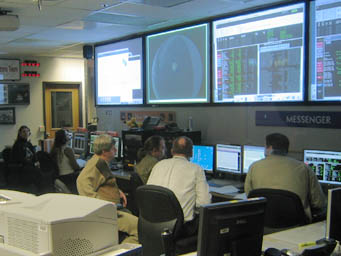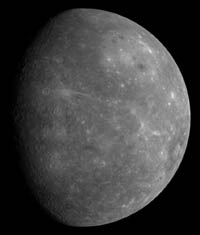The planet Mercury and I go way back. In 1973, when NASA launched Mariner 10 to pay it a visit, I was a Caltech undergrad working for the head of the mission's imaging team. So I was on hand at the Jet Propulsion Lab when the first-ever close-ups of Mercury came in the following year.
A few months later I left California to join the staff of Sky & Telescope. Mariner 10 would fly past the planet two more times, in September 1974 and March 1975, and my first-ever bylined article in S&T was a pictorial writeup following the second flyby. (If you've got the November 1974 issue, look it up!)
What amazed me then, as now, is how Mercury looks superficially so like the Moon — they both have scads of craters, giant impact basins, and broad lava plains — and yet are so very different. Scientists estimate that Mercury's metallic core takes up 75% of its radius and nearly half its volume. How this "iron planet" came to exist remains one of the great mysteries of planetary science.

The control room at Johns Hopkins University's Applied Physics laboratory buzzed with activity during Messenger's first flyby of Mercury on January 14, 2008.
S&T: J. Kelly Beatty
Fast forward to yesterday. NASA's Messenger spacecraft was making the first return visit to Mercury in nearly 33 years (a third of a century, I remind myself), and I just had to be on hand for the reunion. So I took a predawn flight from Boston to Baltimore, then dashed over to the mission control center at Johns Hopkins University's Applied Physics Laboratory for a ringside seat.
I'm thrilled to report that the flyby was 100% "nominal." At 2:04:39 p.m. Eastern time (19:04:39 Universal Time), out of view from both the Sun and Earth, Messenger swept over the planet's night-side equator at an altitude of just 125 miles (less than a mile higher than planned).

Taken by Messenger from about 17,000 miles away, this view of Mercury shows about half of the area not photographed by Mariner 10 in 1974–75. The heavily cratered landscape is reminiscent of other areas previously seen. The broad circular plain at upper right, appearing brighter than its surroundings, marks the interior of Caloris basin, a huge impact scar more than 800 miles across. Click on the image for a full-resolution view.
NASA / JHU-APL / Carnegie Inst. of Washington
Three minutes later it emerged from hiding, reestablished contact with NASA's tracking stations, and then sped off in blazing sunlight on a slightly altered trajectory that will bring it 'round again on October 6th and yet a third time in September 2009. During their fourth and final meeting, in March 2011, Messenger will fire its braking rocket and settle into orbit.
Messenger stands for MErcury Surface, Space ENvironment, GEochemistry, and Ranging — an acronym of sorts no doubt created by NASA's super-secret think tank for mission names. In any case, Messenger carries an impressive array of scientific instruments — and all seven of them were hard at work yesterday. You'll see the eye-popping results here and at the mission's website in the days and weeks ahead.
Back in the mid-1970s, Mariner 10 left us with many unanswered questions about Mercury. Why does it have a magnetic field? What's the source of the tenuous atmosphere that envelops it? And are there really deposits of ice at its poles?
Topping the list of questions is how Mercury came to be so iron-rich. (In fact, after adjusting for compression effects, it's actually denser than Earth.) Something happened at the dawn of solar-system history that set this innermost planet distinctly apart from its terrestrial siblings. As mission leader Sean Solomon confided to me yesterday, "I want to learn how Mercury got put together."
So do I, Dr. Solomon — so do we all.
 12
12
Comments
Joseph Roy D. North
January 16, 2008 at 5:25 pm
It's another wonderful achievement concomitant with Celestial Mechanics, I believe! I hope the following flybys be also successful.
Was Dr. Dunham present therefor?
I'd interested in the Ranging aspect therefor. Many years ago, I recall reading about proposals to actually land a transponder on Mercury's surface for ranging purposes.
How does one adjust for "compression effects", please?!
Is Mercury denser than Earth, or not, please?!
You must be logged in to post a comment.
Alan Silverstein
January 18, 2008 at 10:46 am
Ah, the good old days... While also a Caltech undergrad, a bit behind Mr. Beatty, I pedaled/biked from campus up the old toll road to Mount Wilson, camped in the trees for the night, and coasted down to JPL the next morning. There, I locked up the bike, stored the backpack at Security, and roamed into the cafeteria to watch photos coming back live from Mariner. Must have been one of the two later encounters.
You must be logged in to post a comment.
eanassir
January 19, 2008 at 5:00 am
aaaaa
You must be logged in to post a comment.
eanassir
January 19, 2008 at 5:02 am
The ambiguity and various strange observations about Mercury may be explained by the fact that Mercury has stopped its axial rotation, and it does only orbit around the sun with one hemisphere always facing the sun.
http://universeandquran.741.com/new_page_4.htm#HowPlanetsStandstill
eanassir
http://universeandquran.741.com
You must be logged in to post a comment.
eanassir
January 19, 2008 at 5:06 am
Mercury has stopped its axial rotation, a long time ago, (and was followed by Venus which later on has also stopped its axial rotation). Now both Mercury and Venus do not spin around their axes, but the two still orbit the Sun.
This was because of the depletion of their central heat, by time, because of volcanoes and heat radiation. The next turn will be for the Earth to stop its axial rotation, when its central heat will decrease then finish.
When the planet stops its axial rotation, it will have one of its hemispheres facing the sun; this side will have a lasting or continuous daylight; the other side will have a lasting night darkness.
The day-side will have accumulation of heat that will reach hundreds of degrees, and the night-side will have extreme coldness and freezing that will lead to the extermination of life that once existed on both Mercury and Venus.
You must be logged in to post a comment.
eanassir
January 19, 2008 at 5:10 am
Moreover, the core of the planet has already become cold, and its core density then will increase.
The surface of both Mercury and Venus (like our Moon) will be vulnerable to the falling down of comets upon them (particularly on the frozen side), and which will lead to the numerous craters that are ubiquitous there. Comets, when falling, will leave craters, but comets themselves will dig and bury under the ground; so that no remarkable rocks will be found in the craters.
http://universeandquran.741.com/new_page_4.htm#FallingofComets
The atmosphere of the planet, that has stopped its axial rotation, will undergo many changes: like the smoke and turbidity of its atmosphere; because of the mixing up of the gaseous constituents of the layers of its atmosphere. In addition, its weakened gravity, will lead to the loss of considerable amount of its atmospheric gases.
http://universeandquran.741.com/new_page_4.htm#SkyDisturbed
eanassir
http://universeandquran.741.com
You must be logged in to post a comment.
Jagadheep Pandian
January 19, 2008 at 7:02 am
Eanassir, please stop spreading misinformation. Mercury has NOT stopped rotating. Even an object like the Moon, which keeps the same face towards Earth has not stopped rotating. In order for a body to keep one face towards another body, it has to rotate around its axis once per revolution. In other words, the orbital period and rotation period has to match.
In the case of Mercury, it is in a 3:2 resonance with the Sun i.e. it spins around itself thrice per two revolutions around the Sun. This was first discovered using radar observations. I will not comment on the other fallacies in your posts above.
You must be logged in to post a comment.
arbizu
January 19, 2008 at 3:55 pm
Is your magazine edited for the USA only?
americans (better North Americans, because there are
three, you know) please adopt the metric system, join
the world, including the intelligent world and leave
the middle ages.
The same goes to the magazine, do they think they are
alone in the world.
I´m a new reader and already disappointed with your miles,
inches, gallons and on and on.
The magazine should show some respect for "the other
world" and offer the equivalents in the metric system.
You must be logged in to post a comment.
Enrico the Greta
January 20, 2008 at 12:07 am
This a and bove comments from Arbizu and Eanassir are good examples of the downside of the Internet and the computer age. Eanassir has a warped view of scientific reality and has a forum to spread disinformation. Arbizu has chosen a SCIENTIFIC forum to express his badky concealed contempt for "North Americans", by way of his smarmy comments about the use of the old Imperialm units of measurement. Just WHAT is he actually reading? Sky and Telescope uses the METRIC system! Arbizu must have been thrown off his feed by casual use somewhere in the magazine and/or website of the Imperial system. Since Arbisu has good command of the English language, I suggest that he consult ANY English Dictionary for the Metric equivalents of whatever nonmetric measures he may encounter in his readings. EDUCATE YOURSELF!!!
You must be logged in to post a comment.
Enrico the Great
January 20, 2008 at 12:35 am
I typed a bit too fast and consequently made too many typos for my taste, so my corrected comment follows:
The comments above from Eanassir and Arbizu are good examples of the downside of the Internet and Computer Age. Eanassir has a warped and inaccurate view of scientific reality and has a forum to spread disinformation. Arbizu has chosen a friendly SCIENTIFIC forum to express his badly
concealed contempt for "North Americans", by way of his smarmy comments about the use of the old Imperial units of measurement. Just WHAT is he reading? Sky and Telescope uses the METRIC system! Arbizu must have been put off his feed by casual use somewhere in the magazine and/or website of the Imperial System. Since Arbizu has good command of the English language, I suggest that he consult ANY English Dictionary for the Metric equivalents of any Imperial unit of measurement that he may come accross in his readings that he is baffled by. EDUCATE YOURSELF!!!
You must be logged in to post a comment.
Enrico the Great
January 20, 2008 at 12:43 am
Oh, and by the way, Eanassir can get better information about the rotation of Mercury by reading any General Astronomy book published in the last 35 years or so.
The facts learned by using the Scientific Method are much more fascinating than the Pseudoscience indulged in by way too many people.
You must be logged in to post a comment.
Enrico the Great
January 20, 2008 at 12:44 am
Oh, and by the way, Eanassir can get better information about the rotation of Mercury by reading any General Astronomy book published in the last 35 years or so.
The facts learned by using the Scientific Method are much more fascinating than the Pseudoscience indulged in by way too many people.
You must be logged in to post a comment.
You must be logged in to post a comment.